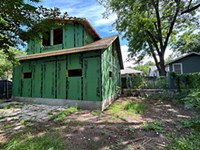Suburbanites Opt to Leave Austin, While Voters Keep Austin Blue in Weekend Election
Turnout was about 6% for the historic election
By Austin Sanders, Fri., May 10, 2024
After years of costly struggle, residents of the Lost Creek neighborhood in Southwest Austin finally got their wish: They no longer have to be Austinites. And another person – yes, one single voter – decided the same outcome in River Place, a Northwest Austin suburb. That area will also be removed from the city’s jurisdiction.
These are just two of the results of the May 4 election, where voters in other outlying areas of the city also voted to disannex. At the same time, Travis County voters elected, for the first time, members of the Travis Central Appraisal District’s board of directors, who play a part in valuing local homes.
Most people living in the Lost Creek neighborhood never wanted to be annexed by the city of Austin (one neighborhood report estimates the neighborhood association spent $250,000 between 2005 and 2007 to lobby the Texas Legislature to prevent such a fate), but the city’s insatiable appetite for land and taxpayers could not be stopped. In 2015, the neighborhood was officially annexed.
Thanks to a law passed by the Lege in 2021 (one that seems specifically tailored to help recently annexed areas, like Lost Creek, in cities across Texas) that nearly decade-old annexation has been undone. The law, House Bill 3053, automatically triggers disannexation elections in areas annexed by municipalities with populations of 500,000 or more that occurred between 2015 and 2017. Lost Creek residents approved a proposition authorizing disannexation with a whopping 91% of the vote. Now, the people on the 738 acres of land adjacent to the Barton Creek Greenbelt will be governed locally by Travis County and a limited district elected by people living within the neighborhood.
The primary motivations for disannexation, per a campaign website for the proposition, were rising property taxes and declining municipal services. Rather than pay the city for service that residents view as lackluster, they will instead, in some cases, contract with private entities to provide those same services – like wastewater management and trash collection (Lost Creek voters also approved a proposition allowing them to join Travis County Emergency Service District 9 in Westlake for fire response, and the Travis County Sheriff’s Office will provide police response).
What motivated the disannexation effort for River Place is less clear, because there was not a strong campaign for or against, unlike with Lost Creek. And only one person cast a vote in the election (in favor), so the proposition passed. It is unclear how many people actually live in this area (when it was annexed in 2017, only three residential streets were affected), but 2,768 voters are registered at the precinct where the single ballot was cast.
Along with Lost Creek and River Place, voters living along Blue Goose Road in Northeast Austin also voted to disannex (three votes in favor, none against; 5,331 voters are registered at the precinct where the three ballots were cast). Two disannexation propositions (one covering 104 acres in far Northeast Austin and one covering 4 acres in South Austin) failed because no one voted for or against. People living in the Lennar Malone neighborhood in South Austin were the lone exception – they voted overwhelmingly against leaving Austin (110 votes against, two votes for).
After City Council canvasses the election results, the removal process will begin formally. Before that process completes, the areas that approved disannexation will first have to pay off their share of the city’s debt incurred to pay for projects like infrastructure improvements (about $7.7 million from Lost Creek). City staff anticipates each area will pay off their debt in two years.
How Much a House Is Worth

In the countywide contest, the Travis County Democratic Party swept the TCAD races. Jett Hanna, Daniel Wang, and Dick Lavine each won their elections handily over Republican opponents (notably Don Zimmerman, who lost to Hanna by 39 points, and Matt Mackowiak, who lost to Wang by 42 points). The three will be sworn in on July 1, where they will join nine other board members who were appointed by the Austin City Council, Austin ISD Board of Trustees, and Travis County Commissioners Court. The appointed directors’ terms end later this year; at that point, the number of appointed directors will reduce from nine to five.
TCAD is the district that contracts with taxing entities throughout Travis County to appraise residential and commercial property values, which taxing entities then use to generate tax revenue. Primarily, TCAD’s board of directors hires the district’s chief appraiser, approves the district’s budgets, and appoints members to the volunteer Appraisal Review Board, which is tasked with settling disputes between property owners and the district over appraised values.
Democrats described the election, also mandated by a recently enacted state law, as one that could impact the future of school funding. If anti-tax Republicans like Zimmerman or Mackowiak were elected, Democrats up and down the party argued, they could work to devalue properties throughout the county, which would lower the amount of funding generated by school districts, which depend on property tax funding.
TRAVIS CENTRAL APPRAISAL DISTRICT, BOARD OF DIRECTORS, PLACE 1
Don Zimmerman 15,653
Jett Hanna 35,597
TRAVIS CENTRAL APPRAISAL DISTRICT, BOARD OF DIRECTORS, PLACE 2
Shenghao ‘Daniel’ Wang 34,495
Jonathan Patschke 3,912
Matt Mackowiak 12,793
TRAVIS CENTRAL APPRAISAL DISTRICT, BOARD OF DIRECTORS, PLACE 3
Bill May 13,504
Dick Lavine 36,574
Prop A (To Disannex Lost Creek)
For 1,447
Against 138
Prop B (To Disannex Mooreland Addition)
For 0
Against 0
Prop C (To Disannex Blue Goose Road Area)
For 3
Against 0
Prop D (Lennar at Malone)
For 2
Against 110
Prop E (To Disannex Wildhorse/Webb Tract)
For 0
Against 0
Prop F (To Disannex River Place)
For 1
Against 0
Editor' Note Wednesday, May 15, 12:12pm: This story incorrectly described River Place as being in Southwest Austin; it is in Northwest Austin, as shown on the map. The Chronicle regrets the error.
Got something to say on the subject? Send a letter to the editor.









